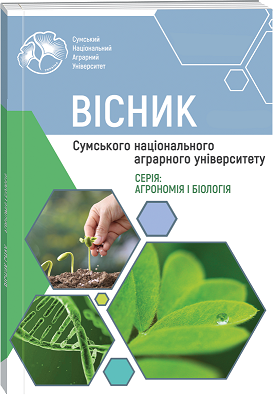THE INFLUENCE OF LABORATORY GERMINATION ON THE YIELD AND SOWING QUALITIES OF WINTER WHEAT IN THE CONDITIONS OF THE NORTH-EASTERN FOREST-STEPPE OF UKRAINE
Abstract
The article presents the results of a study on determining the regularities of the formation of winter wheat sowing productivity and the sowing qualities of seeds, depending on the different laboratory germination of seed material. It was found that the use of seed material with different laboratory germination affects the completeness of winter wheat seedlings - fluctuations in the research options were from 90 to 92 %. Slightly higher rates were on the variant with seed sowing of 85 % germination rate – 92 %, while the plant density was 413 pcs/m2. The conducted accounting of the density of winter wheat plants during the harvesting period showed that this indicator was higher in the control variant with a standard laboratory germination of 92 %, the density of productive stalk was 704 pcs/m2 with a tillering coefficient of 1.72. Over the years of research, the individual productivity of winter wheat plants of the Dostatok variety varied significantly under the influence of factors that were put to study. A larger number of grains in an ear was formed by plants with a laboratory germination rate of 85 % – 43.7 pcs/ear. A heavier grain (1000 grain weight) was obtained in the control variant with a laboratory germination rate of 92 % – 43.7 g. The analysis of the yield data made it possible to reveal the linear dependence of the grain yield on the laboratory germination of the sown seeds, while the coefficient of determination was 0.99. It was found that sowing with winter wheat seeds with a standard similarity of 92 % allows, on average, according to three-year data, to form grain yield at the level of 7.41 t/ha, which is 0.03 t/ha more compared to the option where seeds were sown with laboratory similarity of 85 % and 0.07 t/ha – with 80 % similarity. It should be pointed out that the difference between the yields on the studied variants was not significant. The effect of sowing seeds with different laboratory germination rates on the sowing qualities of the harvested crop after cleaning was studied. The nature of changes in the laboratory germination of the harvested grain according to the analysis results was similar to the germination energy. It should be noted that in all variants of the study, the similarity of the harvested grain was higher than the standard 92 %.
References
2. Müller, D., Jungandreas, A., Koch, F., & Schierhorn, F. (2016) Impact of Climate Change on Wheat Production in Ukraine. Agricultural Policy Report. Kyiv, 41.
3. Lebíd,' Ê. M., &Shevchenko, M. S. (2008) Scientific foundations and evaluation of the effectiveness of grain production in Ukraine. Dnípropetrovs'k: Ínstitut zernovogo gospodarstva, 33–34, 3–7.
4. Poperelja, F., Chervonis, M., & Lytvynenko, M. (2003) Strategy for the cultivation and use of Ukrainian wheat in market conditions. Prypozycija, 5, 10–13.
5. Gyrka, A. D. (2016) Features of realization the productivity potential of winter and spring wheat varieties in northern steppe of Ukraine. Bjuleten' Instytutu sil's'kogo go spodarstva stepovoi' zony NAAN Ukrai'ny, 11, 27–30.
6. Tsyliuryk, A. I., Tkalich, Yu. I., Masliiov, S. V., & Kozechko, V. I. (2017) Impact of mulch tillage and fertilization on growth and development of winter wheat plants in clean fallow in Northern Steppe of Ukraine. Ukrainian Journal of Ecology, 7(4), 511–516. doi: 10.15421/2017_153.
7. Shaporyns'ka, N. M. (2005) Productivity and quality of grain and seeds of winter soft and durum wheat varieties depending on growing conditions in the south of Ukraine: Avtoref. dys... kand. s.- g. nauk: 06.01.09. Hersons'kyj derzh. agrarnyj un-t. Herson. 16.
8. DSTU 2240-93. Agricultural seeds. Varietal and sowing qualities. Tehnichni umovy. K.: Derzhstandart Ukrai'ny, 1994, 73.
9. Romanenko, O. L., Rybka, V. S., Kompanijec', V. O., & Kulyk, A. O. (2009) Agrobiological and economic issues of growing modern varieties of winter wheat in the southern Steppe of Ukraine. Bjul. In-tu s. g. step. zony NAANU, 37. 10. Netis, I. T. (2004). Winter wheat in the Steppe zone. Ajlant, Herson, 95.
11. Vozhegova, R., Zajec', S., & Kovalenko, A. (2013). Practice shows that little moisture in the South Steppe zone can be compensated by placing winter wheat over black fallow. Zerno i hlib, 4, 36‒38.
12. Silveira, G. D., Carvalho F.I.F.D., Oliveira, A.C.D., Valério, I.P., Benin, G., Ribeiro, G., Crestani M., Luche, H.D.S., & Silva, J.A.G.D. (2010) Efeito da densidade de semeadura e potencial de afilhamento sobre a adaptabilidade e estabilidade em trigo. Bragantia, 69(1), 63‒70.
13. Geleta, T. (2017) Vliyaniye normy vyseva i metoda poseva na kachestvo semyan sortov myagkoy pshenitsy (Triticum Aestivum L.) v rayone Khoro, zapadnaya Efiopiya. Malaziyskiy zhurnal meditsinskikh i biologicheskikh issledovaniy, 4(2), 117–128. doi: 10.18034/mjmbr.v4i2.436.
14. Abati, J., Brzezinski, C. R., Zucareli, C., Foloni, J. S. S., & Henning, F. A. (2018) Growth and yield of wheat in response to seed vigor and sowing densities. Revista Caatinga, 31(4), 891–899. doi: 10.1590/1983-21252018v31n411rc.
15. Tavares, L.C.V., Foloni, J.S.S., Bassoi, M.C., & Prete, C.E.C. (2014). Genótipos de trigo em diferentes densidades de semeadura. Pesquisa Agropecuária Tropical, 44(2), 166‒174.
16. Finch-Savage, W. E., & Bassel, G. W. (2016) Seed vigour and crop establishment: extending performance beyond adaptation. Journal of Experimental Botany, 67(3), 567‒591.
17. Scheeren, B. R., Peske, S. T., Schuch, L. O. B., & Barros, A.C.A. (2010) Qualidade fisiológica e produtividade de sementes de soja. Revista Brasileira de Sementes, Londrina, 32(3), 35‒41.
18. Petter, F. A., Silva, J. A. D., Zuffo, A. M., Andrade, F. R., Pacheco, L. P., & Almeida, F. A. D. (2016). Elevada densidade de semeadura aumenta a produtividade da soja? Respostas da radiação fotossinteticamente ativa. Bragantia, 75(2), 173‒183.
19. Van Der Meulen, A., & Chauhan, B. S. (2017) A review of weed management in wheat using crop competition. Crop Protection, 95, 38-44, doi: 10.1016/j.cropro.2016.08.004/
20. Abati, J., Brzezinski, C. R., Foloni, J. S., Zucareli, C., Bassoi, M. C., & Henning, F. A. (2017) Seedling emergence and yield performance of wheat cultivars depending on seed vigor and sowing density. Journal of Seed Science, 39(1), 58‒65.
21. Methodical instructions for conducting field research and studying the technology of growing grain crops. (2001). Chabany : Instytut zemlerobstva UAAN, 22.
22. Dospehov, B. A. (1985). Field experiment technique (with the basics of statistical processing of research results). 5-e yzd., dop. y pererab. M. : Agropromyzdat, 351.
23. DSTU 4138-2002. Agricultural seeds. Terms and Definitions. Derzhstandart Ukrai'ny, Kyiv, 2003, 173.
24. Avdonina N. S. (2003). The value of the absolute weight of seeds in the size and quality of the wheat crop. Zbirnyk naukovyh prac' MNDIP im. M. V. Remesla, 56‒61.
25. Donec', M. M. (2007). Seed breeding with the basics of breeding: a tutorial. Agrarna nauka, Kyiv, 337.
26. Strona, Y. G. General seed science of field crops. M. : Kolos, 1966. 464.
27. Kyrpa, N. Ja. (2011). A moment before sowing (about seed quality). Zerno, 3, 106‒109.
28. Carolina Pereira Cardoso, José Henrique Bizzarri Bazzo, Jéssica de Lucena Marinho, Claudemir Zucareli (2021) Effect of seed vigor and sowing densities on the yield and physiological potential of wheat seeds. Journal of Seed Science, 43, e202143002, 1–11. doi: 10.1590/2317-1545v43241586.

 ISSN
ISSN  ISSN
ISSN 


